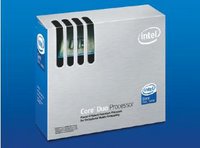Intel Core Duo Processor under X-Ray
 "Intel® Core™ Duo Processor breaks new ground. Its dual-core technology rewrites the rules of computing, delivering optimized power efficient computing: breakthrough performance with amazingly low power consumption. Intel® Core™ Duo Processor is at the core of Intel’s premium desktop and notebook platforms: Intel® Core™ Technology and Intel® Centrino® Duo mobile technology respectively."
"Intel® Core™ Duo Processor breaks new ground. Its dual-core technology rewrites the rules of computing, delivering optimized power efficient computing: breakthrough performance with amazingly low power consumption. Intel® Core™ Duo Processor is at the core of Intel’s premium desktop and notebook platforms: Intel® Core™ Technology and Intel® Centrino® Duo mobile technology respectively."What do all those really mean? If you break down the processor, here is what you get.
•Intel Smart Cache
32KB Level-1 instruction & data cache, 2MB Level-2 cache
Cache is a memory area where frequently accessed data can be stored for rapid access. Think of it as your PC's desktop. Your brain is the cores that process and use the files on the desktop.
•Intel Digital Media Boost
There are 13 new instructions for 3D graphics and entertainment applications called SSE3. You have probably heard about SSE, SSE2, they belong to the same family for the same purpose. They are special instructions for parallel processing.
•Intel Dynamic Power Coordination
The technology manages which core gets to rest. Remember in Core Duo Processor, they are two identical processor cores. Not both processor cores are used at all time. When that happens, one core will go to sleep to conserve power.
•Enhanced Intel® Deeper Sleep with Dynamic Cache Sizing
When the processor is in "deep sleep", data in Level-2 cache will be moved to the main memory for the sake of data integrity.
•Intel® Advanced Thermal Manager
Temperature in the processor is monitored using sensors that are more accurate to feed enough data for the power management logic.
•Power-Optimized 667MHz System Bus
4X data bus and 2x address bus working together to bring a total bandwidth of 5.33GB/s limited only by the speed of the address bus. The address bus is used to locate the data and the data bus is used to transfer data.
Power-Optimized bus normally just means a bus that matches the new power saving features of the core.
•Enhanced Intel SpeedStep® Technology Support
The technology enables to processor to run on multiple voltage and operating frequency point effectively thus saving even more power. This feature must work closely with the operating system.
•Intel® Virtualization Technology
Virtualization is a technique for managing and presenting resources functionally, regardless of their physical layout or location. This feature must work closely with the operating system.
This is very similar to the rooms in your house where you may have one living room, one master bedroom and two guess bedrooms. These rooms are all under one roof and one house but are partitioned for different purpose.
•Advanced Branch Prediction
High performance pipelined processor such as Intel Core Duo must fetch the next instruction before they have completely executed the previous instruction. If the previous instruction was a branch, then the next-instruction fetch could have been to the wrong place. Branch prediction is a technique that attempts to infer the proper next instruction address. If the wrong instruction is fetched, the whole pipeline is flushed.
In general, the rule is the higher the chance of flushing the pipeline, the lower the processor's performance. Therefore, in every new processor launch, there were improvements in the branch predictor.
•Execute Disable Bit
The technology prevents some classes of viruses and worms that exploit buffer overrun vulnerabilities. You lock a memory area by setting a bit to prevent changes. This feature must work closely with the operating system.
•Micro FCPGA & FCBGA packaging technology
The packaging technology fits the processor in a package that is safe enough for human handling. The actual processor is very small and difficult to handle by hand. With the introduction of a new class of processor, the packaging also changes due to design changes.
0 Comments:
Post a Comment
<< Home